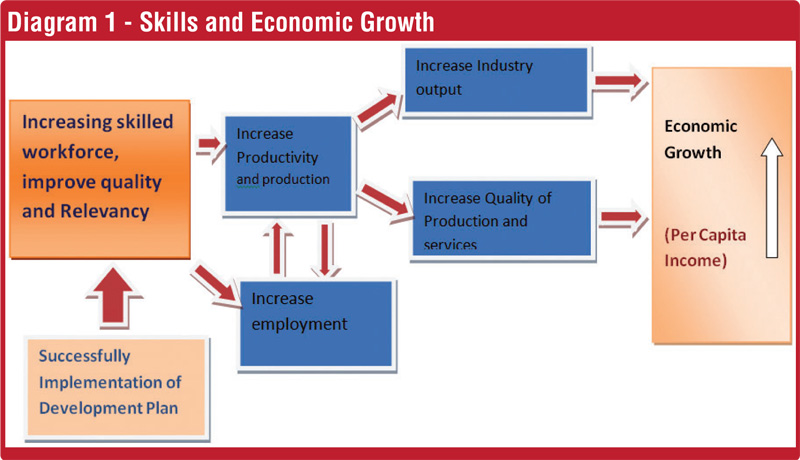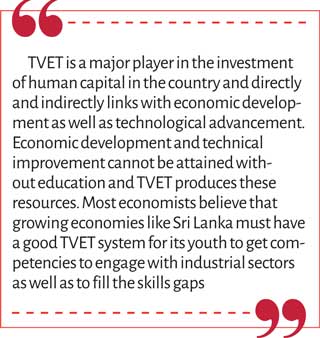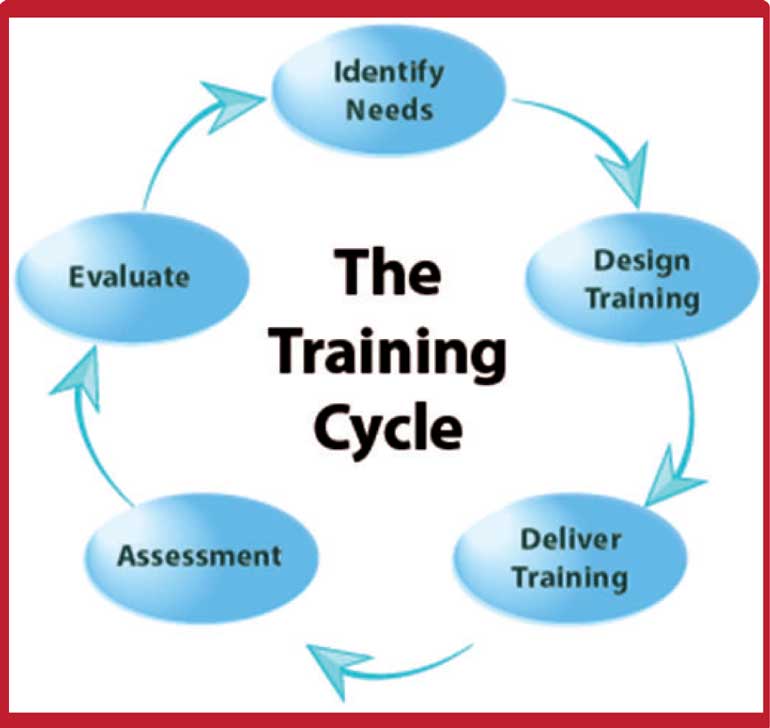Tuesday Apr 22, 2025
Tuesday Apr 22, 2025
Wednesday, 8 September 2021 00:00 - - {{hitsCtrl.values.hits}}

 Tertiary and Vocational Education Commission (TVEC) in the State Ministry of Skills Development, Vocational Education, Research and Innovation (SDVER&I) along with all Technical, Vocational Education and Training (TVET) institutes responsible for implementing the TVET Strategic/Development plan, in order to fulfil the skilled manpower gaps in dynamically changing industries and reduce the unemployment issues, to reach higher per capita income have drafted a plan of action for the country.
Tertiary and Vocational Education Commission (TVEC) in the State Ministry of Skills Development, Vocational Education, Research and Innovation (SDVER&I) along with all Technical, Vocational Education and Training (TVET) institutes responsible for implementing the TVET Strategic/Development plan, in order to fulfil the skilled manpower gaps in dynamically changing industries and reduce the unemployment issues, to reach higher per capita income have drafted a plan of action for the country.
The drafted plan was submitted to the Ministry for approval from President Gotabaya Rajapaksa and subsequently to stakeholders for comments and further modifications. Once the President approves the plan, it will be published in the Government Gazette and all training delivery organisations and other relevant organisations will be committed to implement the plan under supervision of the Ministry and regulation of the TVEC. This article is focused to elaborate thought and practice of TVET in alignment with Government policy targets throughout the proposed development plan.
Introduction of a skilled workforce and human capital
A skilled workforce is the most important input of the production process and it is the vibrant part of the human capital development in a country. According to OECD, human capital is defined as: “The knowledge, skills, competencies and other attributes embodied in individuals or groups of individuals acquired during their life and used to produce goods, services or ideas in market circumstances”.
According to the theoretical concept ‘Human capital formation’ is considered as improving the quality of labour. It is the process of transforming people in a country into workforce who are capable of producing goods and services. During this process, relatively unskilled individuals are given the tools they need to contribute to the economy.
The famous Economist Shzults (1961) stated that improvement in human activities due to which a person proves him more productive and more beneficial according to the changes in the economy is called human capital formation. On the other hand, human capital accumulation is the increasing stock of labour and it comprised both segments of skilled and unskilled workers.
TVET is a major player in the investment of human capital in the country and directly and indirectly links with economic development as well as technological advancement. Economic development and technical improvement cannot be attained without education and TVET produces these resources. Most economists believe that growing economies like Sri Lanka must have a good TVET system for its youth to get competencies to engage with industrial sectors as well as to fill the skills gaps.
A significant rate of return to investment in vocational training in Sri Lanka
According to a study conducted by Ranasinghe (2008) on Sri Lanka, the marginal rate of return for general education is 9%, the vocational training is 11% and the unskilled is 9%. And it has been found that the level of earnings of male is 20% higher than that of the female. Furthermore, according to a study, Lalithadheera (2016) has computed that the average rate of return of vocational training is 24%. This means that the earnings of the workers with vocational training increase by 24% when compared to those without vocational training. These findings justify that improving the TVET sector is the most vibrant solution to increase economic growth of the country.
Step to declare ‘World Youth Skills Day’ and Skills Decade
World Youth Skills Day is celebrated globally on 15 July, as proposed by former President Mahinda Rajapaksa to the United Nations General Assembly and accepted in 2014. Furthermore, President Gotabaya Rajapaksa declared this decade ‘Skilled Decade 2021-2030’. (Refer article, Lalitahadheera K.A., 12 Aug 2021 ‘Strategies toward meaningful “Decade of Skills Development”, 2021-2030’;
https://www.ft.lk/columns/Strategies-toward-meaningful-Decade-of-Skills-Development-2021-2030/4-706734).
World Youth Skills Day is the platform to dialogue between young people, technical and vocational education and training (TVET) institutions, firms, employers’ and workers’ organisations, policymakers and development partners. Skills are the most important human capital and they can change the world and achieve sustainable development goals 04 “Ensure inclusive and equitable quality education and promote lifelong learning opportunities for all”.
Government policy direction on TVET
Skills Decade (2021-2030) activities have been focusing on achieving a big target of reducing unskilled workforce to 10%. TVET is the major sector that creates skilled workforce while higher education and general education contributes in different aspects. According to policy area of ‘Productive Citizenry and a vibrant Human resource’ in the Government national policy framework ‘Vistas of prosperity and Splendour’ TVET’s role has been defined as
Provide vocational and technical opportunities to needy students regardless of academic performance.
Rationalise the existing vocational training institutes by introducing “One TVET” Concept and establish properly scattered technical university colleges
Provide wider opportunity to existing workforce to upgrade their skills.
All these enhance the labour market supply policy direction and strategies to reach a better outcome for the sector.
TVET Development Plan 2021-2025 – Getting ready to implement
TVEC as the apex body in the TVET sector in Sri Lanka is empowered to accomplish its mandate through the main goals that are; to formulate, review, update and implement robust TVET policies and strategies and planning of TVET activities. The target groups are the school leavers from different grades and employees. TVEC in the Ministry of SDVER&I has taken steps to prepare a development plan for the next five years.
This National Development Plan (NDP) for TVET has been compiled in fulfilment of a statutory requirement imposed on the Tertiary and Vocational Education Commission (TVEC) in terms of Section 11 Sub-section (1) of the Tertiary and Vocational Education Act No. 20 of 1990. Draft proposals were published on TVEC web site to get the stakeholder views to further aligning it to the development priorities in the country.
Link with national policy framework and macroeconomic goals
Macroeconomic targets are mentioned in the national policy framework – Vistas of prosperity and splendour for 2020-2025;
Achieve an economic growth at 6.5% or higher,
Per capita income exceeding $ 6,500.
The rate of unemployment to be maintained at less than 4%.
Although the prevailing pandemic situation has affected the labour force and global economy, TVET sector work toward achieving maximum targets is ongoing though under certain limitations. Increasing skilled workforce directly affects the production process, shortages of skilled workers is the major issue that hampers industrial sectors’ growth. Skills will help to increase the industry output and skilled workers earn incomes much higher than unskilled workers. Ultimately it will reduce the unemployment rate and significantly increase the economic growth as mentioned in Diagram 1.
 Six key thematic areas in the development plan
Six key thematic areas in the development plan
The development plan has identified six thrust areas to be developed in the next five years and also strategic areas under each trust areas has been as mentioned below.
1. Accessibility to technical, vocational education and training programs
It is most important to enhance accessibility of TVET programs in different industrial sectors. Most of the training organisations have the problem of low enrolment due to negative attitudes in different social groups.
National Policy on TVET has allocated two chapters to Accessibility to TVET; Theme 1. Is Increase Access to TVET’ and Theme 2 is the access to TVET for vulnerable and disadvantaged people’. Career Guidance is the effective mechanism which uses to change youth attitude towards increase accessibility. Six strategic areas have been identified to be performed under this first trust area mentioned below.
2. Training developments and rationalisation of training
Competencies can be acquired either through structured training in public or private TVET collages and centres, or through on the job training experience in enterprises apprenticeship. And also, dual training, involving a combination of work-place and institution-based training.
Training development has a process including five steps of identifying training needs, Design training, training delivery, assessment and evaluation. Employment or value addition to the existing jobs is the major outcome of this process.
The TVET system of Sri Lanka does not have a systematically developed policy framework until currently used policy document coordinated by the National Education Commission (NEC) was published in 2018. Therefore, rationalisation of training programs has become an issue and the National Policy on TVET has proposed corrective action. Under this the second thrust area has covered the five strategic directions.
Training materials, NCSs and curricula innovation
National and institutional annual training plan
Promote apprenticeship, enterprise-based training and on-the-job training
Create an environment for private sector to participation in training development and delivery
Assessment management including NVQ Assessment
3. Labour market information and digitalisation
Labour market demand trends are an important factor in planning the TVET. It has a direct relationship with labour market information and planning for skills development should be done considering labour market trends.
Normally digitalisation affects TVET and skills systems and LMI is used as a management tool. Many countries and international organisations provide insights into the nature and scope of digitalisation and how it is likely to affect the TVET management, training delivery, assessment and the certification process.
TVET has to take several actions and human and financial resources have to be mobilised to ensure universal access to digital infrastructure, tools and modern learning technologies. Managerial staff, teachers, trainers and learners themselves need training and support to engage in distance and online learning. Furthermore, it is necessary to revise teaching and learning models to make the best use of digital resources and tools. Under this trust area there are six strategic directions.
Central MIS for TVET sector
Labour Market Information System (LMIS)
ICT enabled career guidance
Inculcate research culture
Online learning
Digitalise practices for occupations those use with minimum IT
4. Industry linkages and workforce development
TVET institutions should have strong linkages with industry in the development and implementation of training courses to ensure that trained people could realise their employment aspirations. Important industry collaboration to TVET process are
Curriculum development and review
Conduct enterprise-based training which is apprenticeship mood training
On the job training for trainees in institutional training
Skills upgrading the existing workforce
At present it has established four industry Sector Skills Councils to explore a more pro-active role from industry for TVET – industry collaboration. Therefore, strengthening TVET- industry linkages and workforce development is an essential part of the entire process and is focused to implement six strategic areas as mentioned below.
Industry sector skills councils and national industrial training advisory council operations
Wages Board recognition for NVQ
Workforce development through Modular Based Courses, RPL and Mature Candidate Route
Effective OJT for TVET students
Partnership with industry for TVET
SME and informal sector development
5. Quality assurance and recognition in TVET
TVEC as the apex body in TVET has the national mandate for coordination, setting standards for vocational education and training and developing an awards system. This trend led to the establishment of the NVQ Framework as a unified qualification system in 2004.
In order to ensure quality and relevance with wide recognition, the NVQ Framework has added the following features to the TVET system.
Strengthen registration of training centres
National Competency Standards (NCS) and National CBT Curricula
Course accreditation to award NVQ certificates
Colleges of Technology and University Colleges to conduct NVQ level 5 & 6 courses
University of Vocational Technology to conduct NVQ Level 7-degree programs
Quality Management System supported by Quality Improvement System
Compulsory OJT for NVQ level 4 and above courses
NVQ Operations Manual
NVQ Assessment and Certification system, through EBT, CBT, RPL and Mature candidate root.
The NVQ system has operated for 19 years and at present it has mapped with Sri Lanka qualification framework (SLQF). However practical issues are arising due to competency gap in the mapping the NVQ levels with SLQF. And also, there are no unique qualification frameworks for international and harmonising NVQ with the international qualification frameworks.is necessary TVEC has taken steps on this regard and planned four strategic areas to achieve the goals in this:
Review and Update NVQ Framework
Quality Assurance in TVET
Review and Revise Legal Framework
Recognition for TVET
6. Management of human resource perspectives of TVET – physical and financial resources
Human resources, physical resources and financial resources are the major inputs to drive the most productive training delivery system. Infrastructure development is most important to improve accessibility to TVET; the image of the physical resources as well as quality of training plays a great role in attracting trainees to follow TVET courses.
Resource allocation for the TVET sector is less than 0.05% of GDP and this is grossly inadequate.
Management of human resources of TVET
Human resource development in TVET
Management of physical resources of TVET
Development and management of financial resources of TVET
Way forward
TVET plays a major role in the development process in the country and proper planning is vital step to promote the sector. Accessibility to resources modified training and development, digitalised information flow system, industry linked and well-managed human and physical resources along with quality assured and assessment process will lead to a quality TVET system.
The national policy document which was prepared by the NEC in collaboration with the TVEC should have a suitable mechanism for successful implementation. TVEC being apex body of the TVET sector, has taken lead action with advice given by the Ministry to prepare a comprehensive development plan based on National Policy framework of the TVET. Ministry intervention will be most important to direct all training providers to implement the plan.
Under the guidance of TVEC and Ministry, each and every organisation such as VTA, DTET, NAITA, NYSC and all public and private organisations in the TVET have a humongous responsibility to achieve targets of increased skilled workforce. The President approved development plan will become the nationally accepted plan which will be used as a guide by the treasury and funding organisations for allocate reasonable funds to the sector and monitoring the effective utilisation of financial and all other resources.
It has a good strategically focused scheme of solutions for sectorial issues that exist for a long period in the skilled workers of industrial sectors as well as skilled manpower supply in the country. TVET leaders need to change their attitude of individual thinking and a new working culture towards system thinking, leadership and management culture of TVET has to be transformed to achieve ‘One TVET’ national policy targets.


(The writer is Director General at Tertiary and Vocational Education Commission (TVEC).)
Discover Kapruka, the leading online shopping platform in Sri Lanka, where you can conveniently send Gifts and Flowers to your loved ones for any event including Valentine ’s Day. Explore a wide range of popular Shopping Categories on Kapruka, including Toys, Groceries, Electronics, Birthday Cakes, Fruits, Chocolates, Flower Bouquets, Clothing, Watches, Lingerie, Gift Sets and Jewellery. Also if you’re interested in selling with Kapruka, Partner Central by Kapruka is the best solution to start with. Moreover, through Kapruka Global Shop, you can also enjoy the convenience of purchasing products from renowned platforms like Amazon and eBay and have them delivered to Sri Lanka.
Discover Kapruka, the leading online shopping platform in Sri Lanka, where you can conveniently send Gifts and Flowers to your loved ones for any event including Valentine ’s Day. Explore a wide range of popular Shopping Categories on Kapruka, including Toys, Groceries, Electronics, Birthday Cakes, Fruits, Chocolates, Flower Bouquets, Clothing, Watches, Lingerie, Gift Sets and Jewellery. Also if you’re interested in selling with Kapruka, Partner Central by Kapruka is the best solution to start with. Moreover, through Kapruka Global Shop, you can also enjoy the convenience of purchasing products from renowned platforms like Amazon and eBay and have them delivered to Sri Lanka.